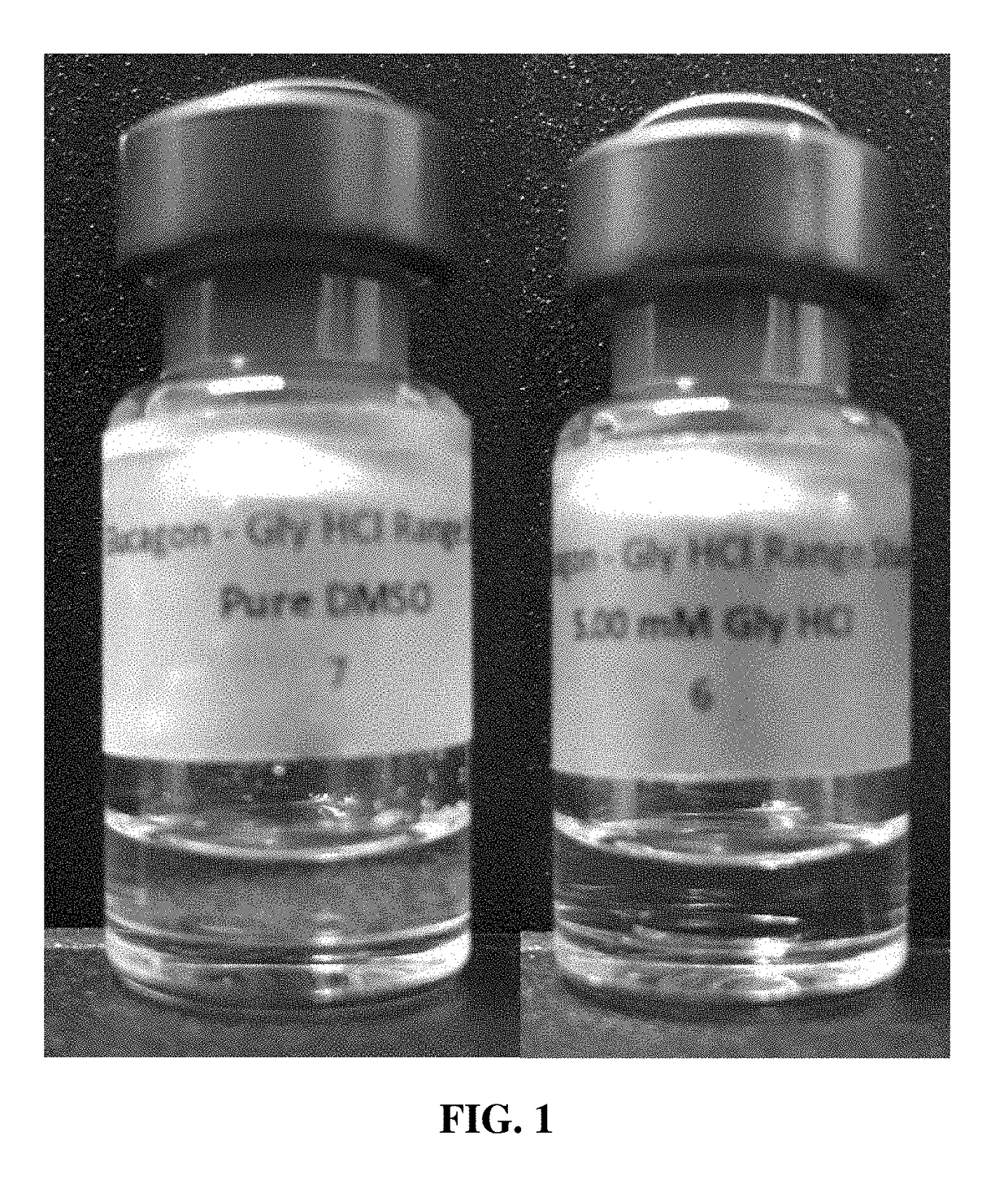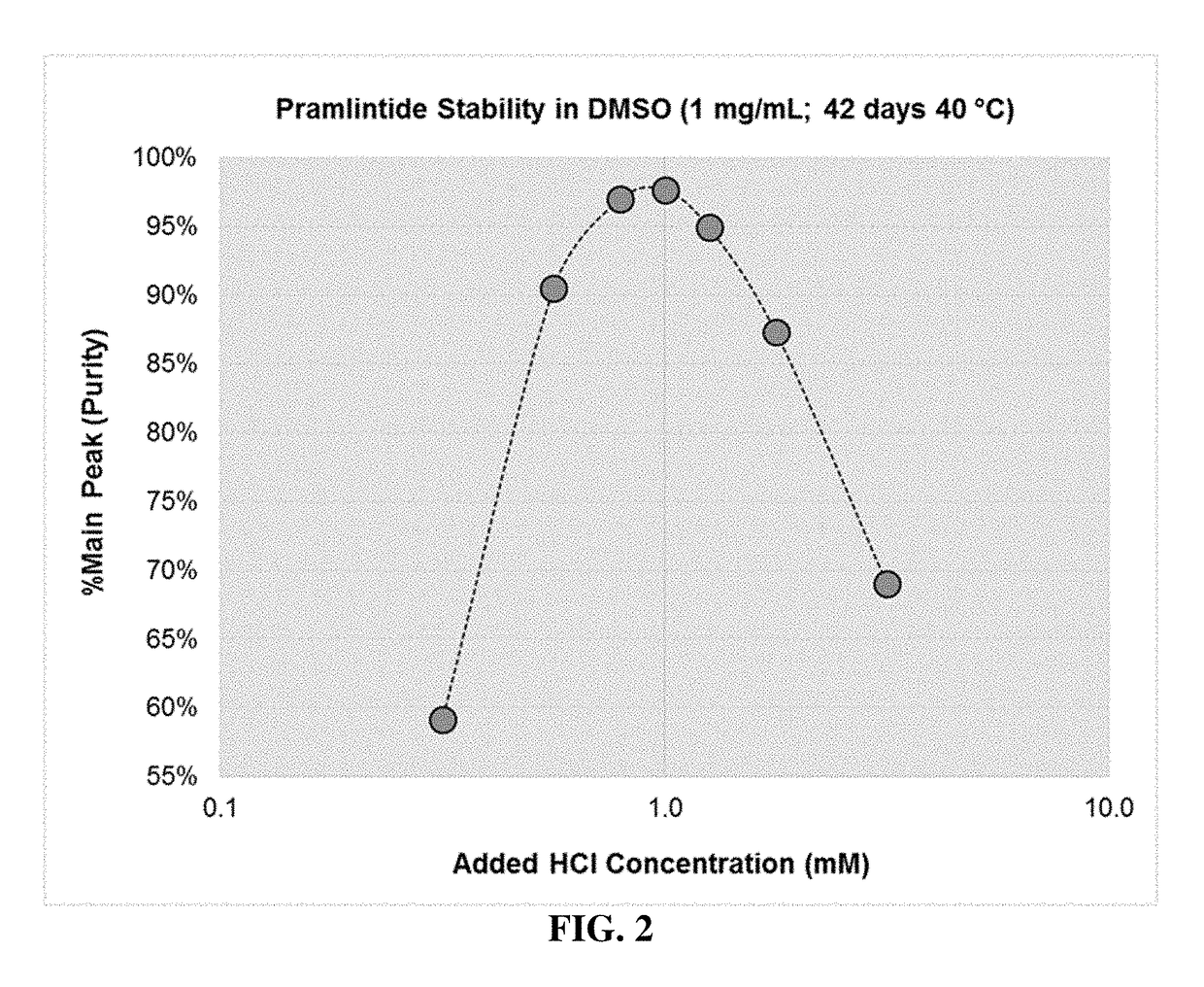Methods for Producing Stable Therapeutic Formulations in Aprotic Polar Solvents
a technology of aprotic polar solvent and stable formulation, which is applied in the direction of peptide/protein ingredients, inorganic non-active ingredients, metabolic disorders, etc., can solve the problems of complex scaling up of drying steps, high cost, and development of drying methods, and achieve optimal or beneficial ionization profiles of therapeutic molecules, prolonging stability
- Summary
- Abstract
- Description
- Claims
- Application Information
AI Technical Summary
Benefits of technology
Problems solved by technology
Method used
Image
Examples
example 1
[0092]In this example, glucagon solutions were prepared by dissolving glycine hydrochloride (CAS No. 6000-43-7) directly in DMSO (CAS No. 67-68-5) at 5 mM, 10 mM, and 20 mM concentrations, followed by dissolution of glucagon powder (MW=3483 g / mol; purchased from Bachem AG) to a peptide concentration of 5 mg / mL. The prepared sample solutions are shown in Table 1:
TABLE 1Glucagon sample solutions prepared by dissolving both glycinehydrochloride and glucagon powder directly in DMSO.Glucagon ConcentrationSolventAdded Excipient5 mg / mLDMSO 5 mM Glycine Hydrochloride5 mg / mLDMSO10 mM Glycine Hydrochloride5 mg / mLDMSO20 mM Glycine Hydrochloride
[0093]The reversed-phase high performance liquid chromatography (RP-HPLC) method used to assess chemical stability was a gradient method with mobile phases A and B respectively consisting of 0.1% (v / v) TFA (trifluoroacetic acid) in water and 0.1% (v / v) TFA in acetonitrile. A C8 column (BioBasic™-8; ThermoScientific) (4.6 mm I.D.×250 mm length, 5 micron p...
example 2
[0098]In this example glucagon solutions were prepared at a concentration of 5 mg / mL by dissolving glucagon powder in DMSO that included different concentrations of added hydrochloric acid, ranging from 0.001 M (1 mM) to 0.01 M (10 mM). To minimize the amount of water added to the formulation, 5 N HCl was utilized to prepare 10 mM and 5.6 mM HCl in DMSO solutions, while 1 N HCl was used to prepare the 3.2 mM, 1.8 mM, and 1.0 mM solutions. As an example, the 10 mM HCl in DMSO solution was prepared by adding 20 μL of 5 N HCl to 9.98 mL of DMSO (neat), while the 1.0 mM HCl in DMSO solution was prepared by adding 10 μL of 1 N HCl to 9.99 mL of DMSO (neat). Samples of each formulation were stored in CZ vials and incubated at 40° C.
[0099]Following both 28 and 58 days of storage the chemical stability of the peptide was assessed by RP-HPLC and the purity reported in Table 3. The addition of 1.0 mM HCl was insufficient to prevent the formation of insoluble aggregates in the 5 mg / mL glucagon...
example 3
[0100]Sample solutions were prepared by dissolving glucagon powder to a concentration of 5 mg / mL in DMSO which contained various added concentrations of glycine hydrochloride (CAS No. 6000-43-7), betaine hydrochloride (CAS No. 590-46-5), or hydrochloric acid (1 N; CAS No. 7647-01-0). The various concentrations of each ionization stabilizing excipient used to prepare the sample formulations are listed in Table 4. Samples of each formulation were stored in CZ vials and incubated at 40° C. Following 28 days of storage the chemical stability of the glucagon peptide was assessed by RP-HPLC and the purity reported in Table 4. This example demonstrates that the proton-donating ability of the added ionization stabilizing excipient (i.e. its ‘strength’) may influence the concentration required to stabilize the therapeutic molecule. Glucagon was selected as a model peptide due to its tendency to gel (i.e. form insoluble aggregates) when the molecule is insufficiently protonated. A concentrati...
PUM
 Login to View More
Login to View More Abstract
Description
Claims
Application Information
 Login to View More
Login to View More - R&D
- Intellectual Property
- Life Sciences
- Materials
- Tech Scout
- Unparalleled Data Quality
- Higher Quality Content
- 60% Fewer Hallucinations
Browse by: Latest US Patents, China's latest patents, Technical Efficacy Thesaurus, Application Domain, Technology Topic, Popular Technical Reports.
© 2025 PatSnap. All rights reserved.Legal|Privacy policy|Modern Slavery Act Transparency Statement|Sitemap|About US| Contact US: help@patsnap.com


